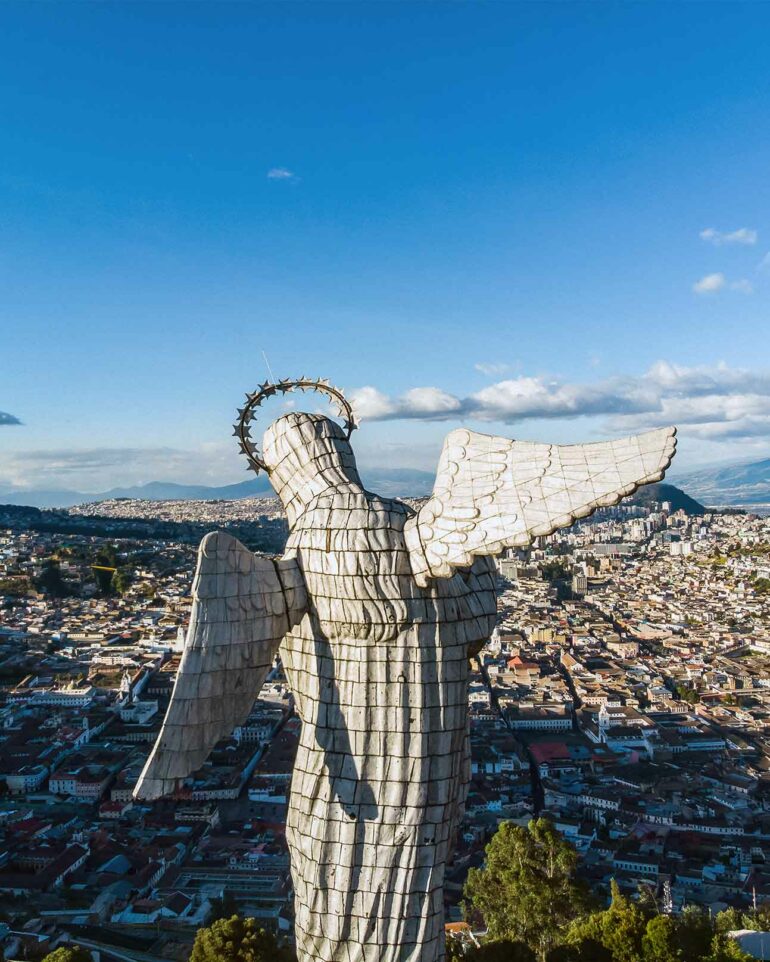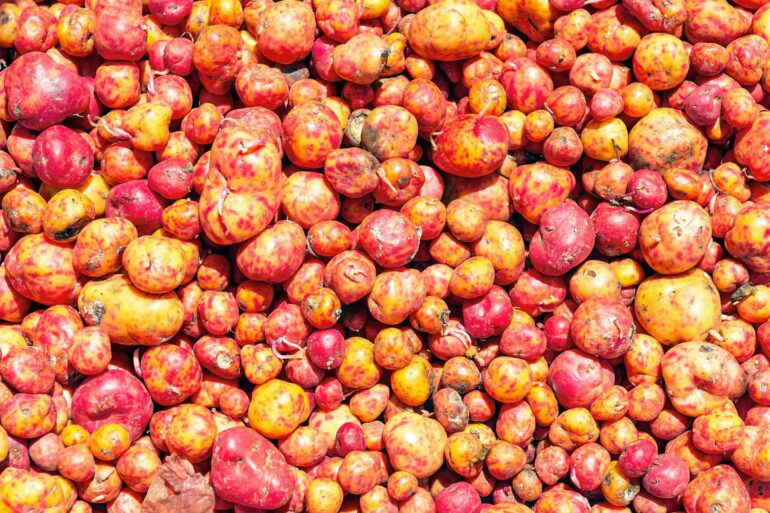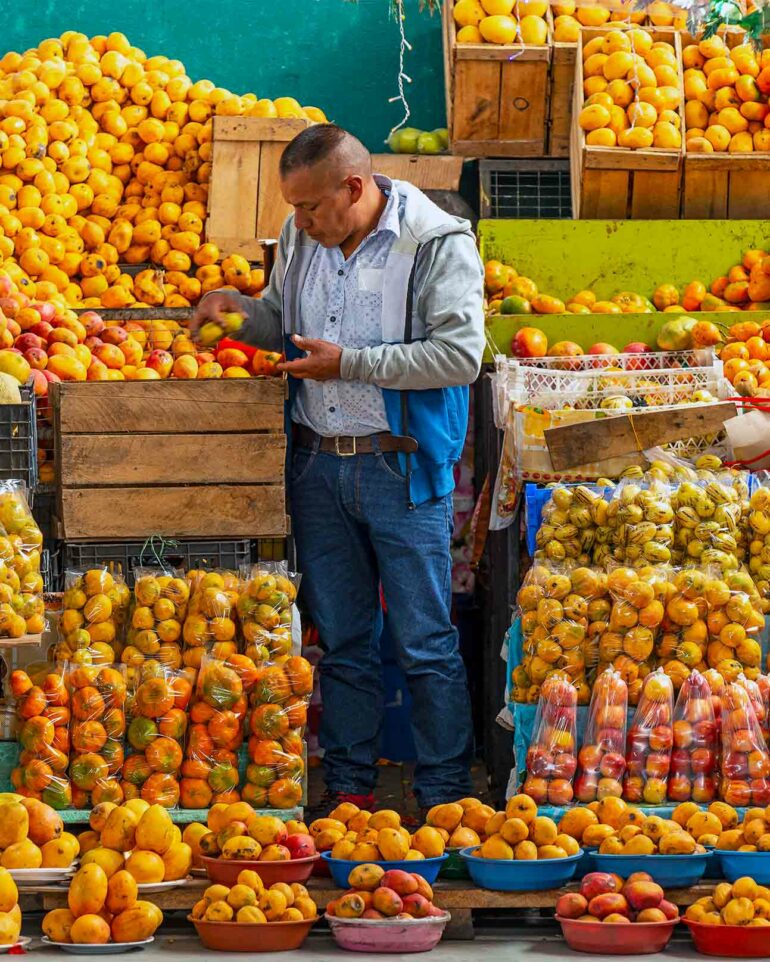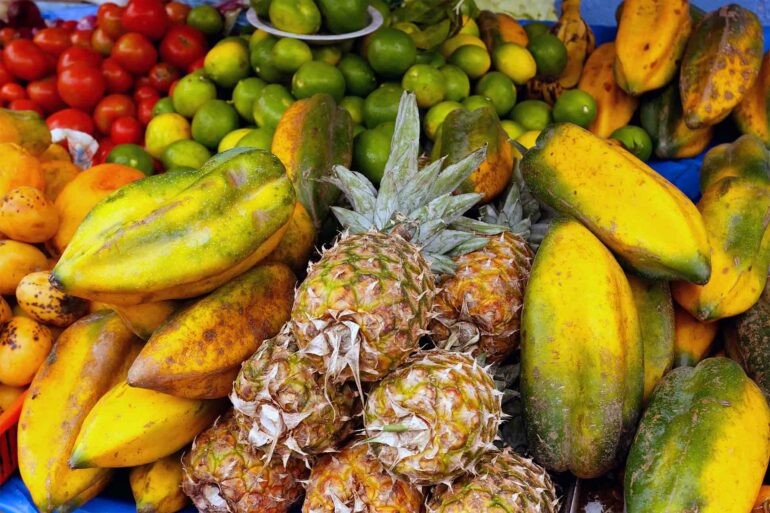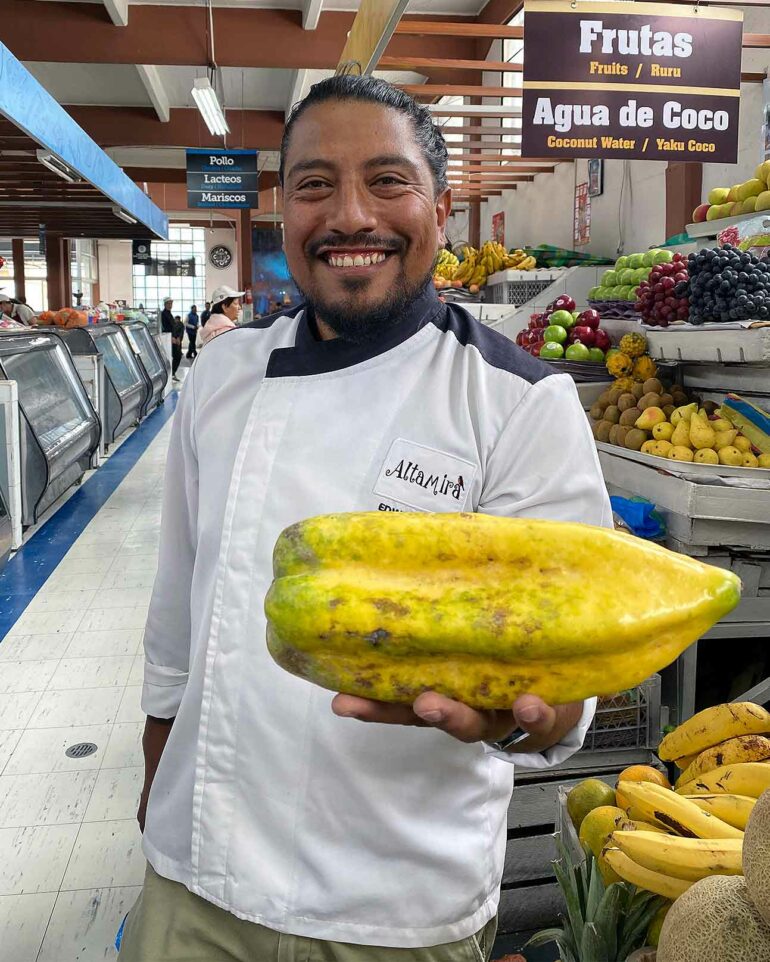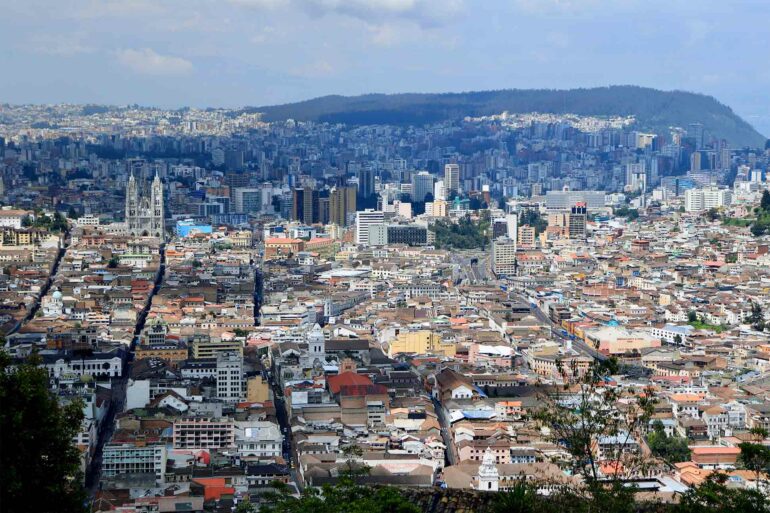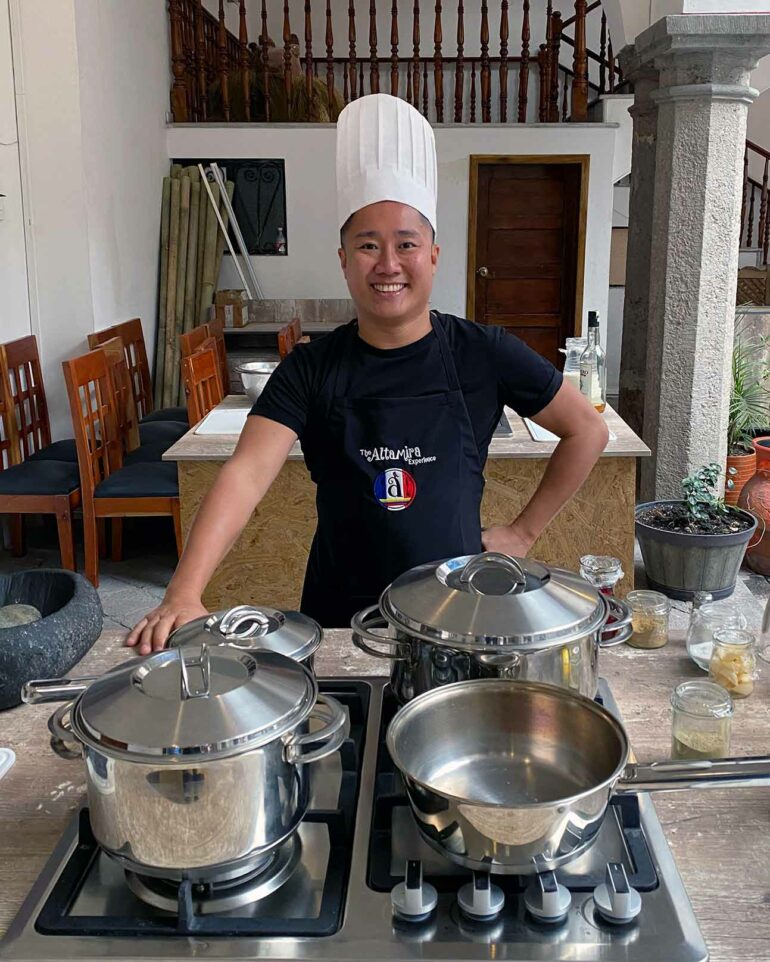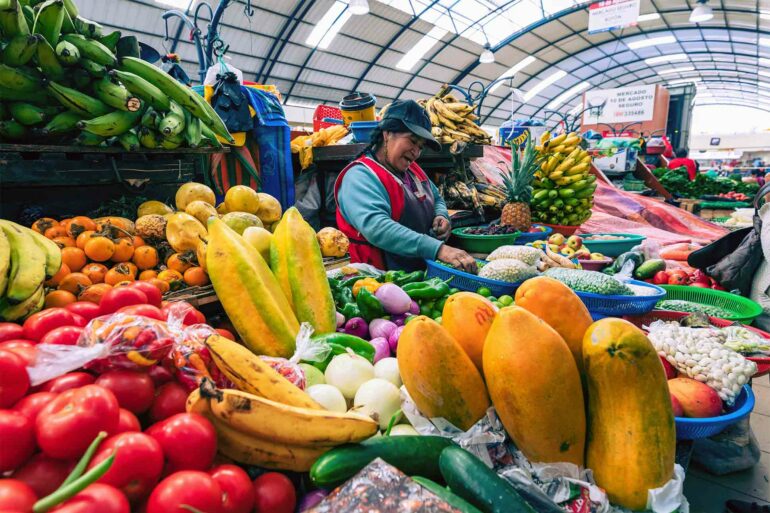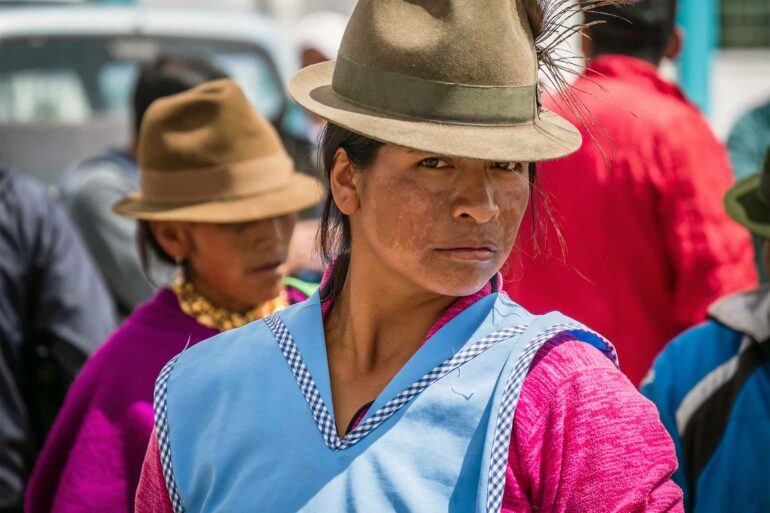Finding a friendly fruit stallholder, Edwin conducts a masterclass in local pomology. I marvel at the naranjilla – Solanum quitoense – a strange fruit that resembles an orange, but not. It’s so local that its genus name means ‘from Quito’. There’s granadilla, from the passion-fruit family, with its white, translucent pulp. Tomate de árbol is a sugary, tangy tree tomato, sometimes called tamarillo. La guaba looks like a pod of beans, but inside it’s like soft-scoop ice cream. The stallholder wants to give me a gift, I can choose a fruit that I’ve never tasted before to take back to the Altamira kitchen with me. I opt for babaco, which looks like a giant papaya, except that it’s star-shaped. I’m told I chose well.
One last stop; to buy another Ecuadorian classic – chocolate – in a less exotic, and far more upscale, boutique setting for the benefit of Quito’s old-town tourists. Republica de Cacao is the ‘Harrods of chocolate’ and we’re introduced to the multitude of different varieties on offer, from the purest ‘brown gold’ to contemporary fusions.
Edwin’s open kitchen is housed in the courtyard of an old colonial building. Together, we prepare a traditional Ecuadorian lunch of locro Quiteño; an Andean potato soup, accompanied by perfectly ripe avocado slices that we learn to flower, without cutting off the tips of our fingers. We boil up an encebollado, a delectable fish stew in rich yellow saffron and coconut sauce, served with deep-fried plantain. To finish, it’s fresh fruit in a melted chocolate and rum sauce. I dig into my babaco, it’s texturally melon-like but fragrant and tastes like pineapple, kiwi and papaya all together. Like the mixed-up jugos it’s rather hard to describe, but it’s Ecuador in my mouth.
Farm to table pleasures
Dinner is a change of pace. Leaving old-town Quito behind, we head for an upmarket, residential district called La Floresta. Here a number of young, next-generation Quiteño chefs are creating a new flavour for Ecuadorian cuisine, in stylish, Miami-esque concept restaurants. They’re advancing the city’s reputation as a hub for contemporary, Latin American dining – influenced by ancient recipes and local produce – mixing up the old knowledge and creating seismic gastronomy as a result.
Terra is one such place, a visionary farm-to-table restaurant inspired by Álvaro Reinoso, a young and personable chef, who introduces the tasting menu he calls a “journey through Ecuador” to me. Proudly Ecuadorian, half Brazilian and trained in Spain, Álvaro defines Quiteño cuisine today, honing the flavours from the four regions of Ecuador, but with an international and experimental edge, in a fabulously furnished, new-meets-old setting.
Exquisite, aromatic gin cocktails set the tone. What follows is pure discovery on multiple, beautiful plates: tapioca chips and chilli jam; thin loin, Dijon-anointed churrasquitos on Andrean potato fries; chorizo blinis; Maduro gnocchi with coriander oil and laminated parmesan; pork belly in a tamarind sauce with green mango; and sea bass with pine-nut hollandaise. Altogether it’s South American, European and Asian – yet distinctly Ecuadorian. It shows respect to the cooking traditions of the past, with old recipes skilfully deconstructed and reimagined creatively. It’s refined, yet comforting, timeless yet futuristic, perfectly plated, yet unfussy.
In my short time in Quito, I’ve encountered an incredibly diverse range of food that attests to the fruitfulness of this beautiful country. There is a great appreciation here of where the food actually comes from; ‘gratitude’, you could call it. I reflect on the name that Chef Álvaro chose for his restaurant, Terra; the diversity of Ecuadorian cuisine comes from the diversity of the land. I wonder why the country’s food hasn’t achieved the global notoriety that its neighbour Peru’s has. A tempestuous political history has probably got a lot to do with it; many I meet here say that Ecuador – and Quito in particular – has only recently started to carve out its own identity in the world, despite its 200 years of being a republic and one of the most touristed countries in South America. I’m also told that the history of its food goes way deeper. There are many trying to revive Criollo food for example, which is a mix of Amazonian, indigenous and black-enslaved tastes, not to mention each community’s individual contribution, eradicated after generations of Latin assimilation. It’s heartwarming to see cuisiniers like Chef Álvaro, Chef Edwin and others working hard to put the country on the foodie map and give it the recognition it deserves.
My take on the food here goes beyond its flavours. There is a unique sense of community and culture in Quiteño cuisine that I savour in each bite. I taste the heritage and demography, even the colonialism and globalisation. Every mouthful tells a story – a family secret, tales of hardship, emancipation, independence, travel, or coming home – and that’s what, to me, makes the food of this city and country so very special.
Uwern travelled to Quito for three nights with Scott Dunn – including a full city tour, the Altamira cooking experience and dinner at Terra – travelling onwards to the Galápagos on a seven-night cruise with Ecoventura. You can book Ecuador, Latin America and more at www.scottdunn.com/outthere.
Photography courtesy of Ecuadorpostales, Alejandro Alfaro, Diego Sugoniaev, dolesi, SL Photography, Curioso Photography, Goran Safarek and Uwern Jong
Get out there
Do…
… experience Quito’s heritage sights. We’re not big lovers of churches and colonial tours, but Quito’s offering will give you some insight into its past. There are 24 old churches in the Old Town alone, but if you had to pick just one to visit, we’d recommend the gilded spectacle of La Compañía de Jesús.
… visit Plaza Grande if you happen to be in the city on a Monday. Every week at 11am there’s an hour-long changing of the guard ceremony, where the President of Ecuador himself will make an appearance and sing the national anthem.
… keep your wits about you. Although we found Quito to be very safe and its people friendly, almost everyone we met told us to be very careful when walking around the city, especially at night.
Don’t…
… miss the chance to straddle the equator. It’s touristy, but when else will you get to do it? San Antonia de Pichincha is just a short drive outside the city and there you’ll find the equatorial Museo de Sitio Intiñan.
… jump into just any cab. Taxis in Quito are all painted yellow, but that doesn’t mean they’re licensed and registered. Always look for a green sticker on the side that shows it’s legit, but better still, get one that is booked by your hotel. Uber is a widespread, cheap and safe option.
… just look both ways before you cross the street. Look left, right and then look again. Drivers in Quito take a very liberal interpretation of the highway code or are often too engrossed in their phone conversations to notice you.


